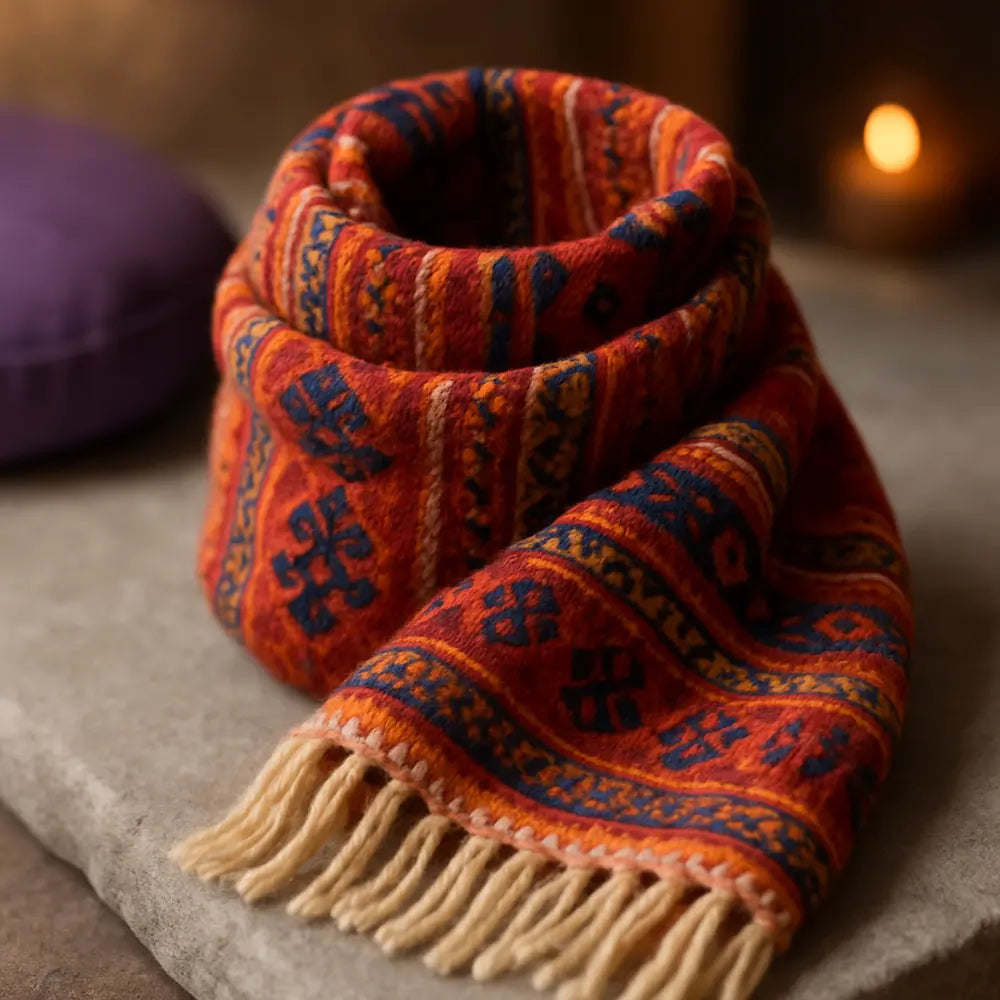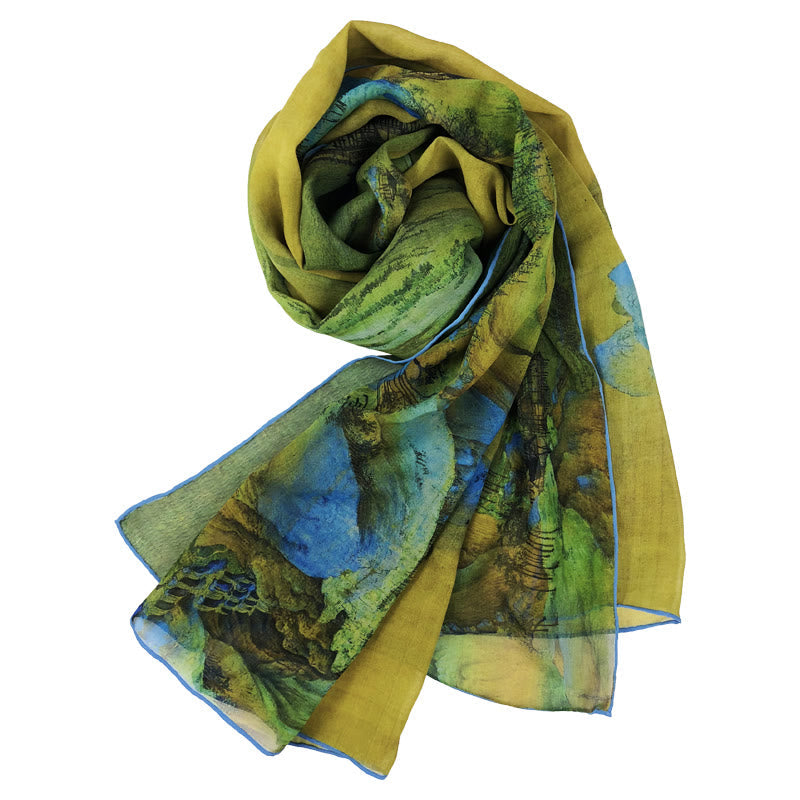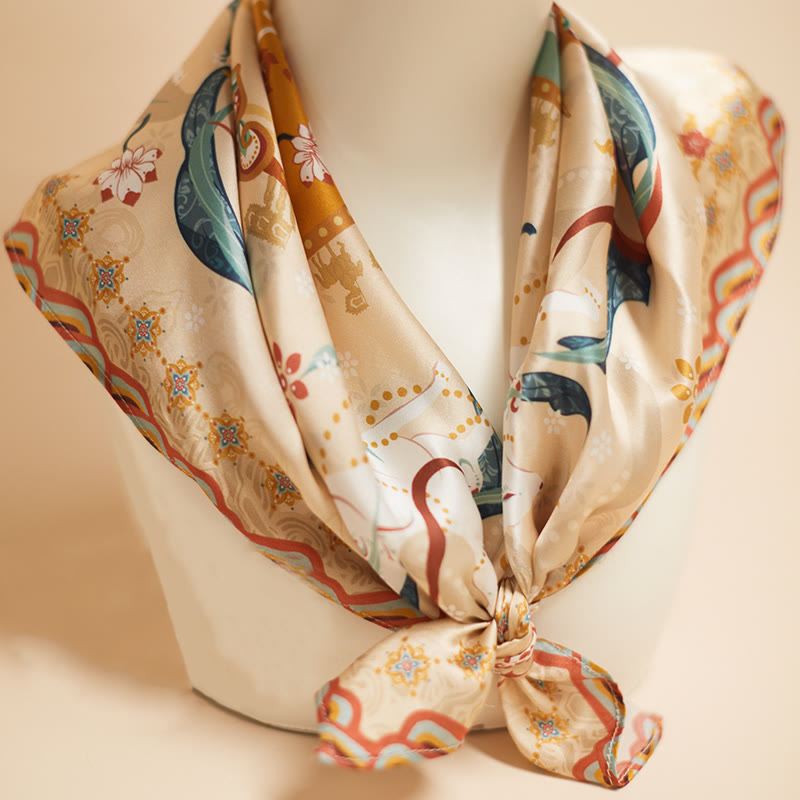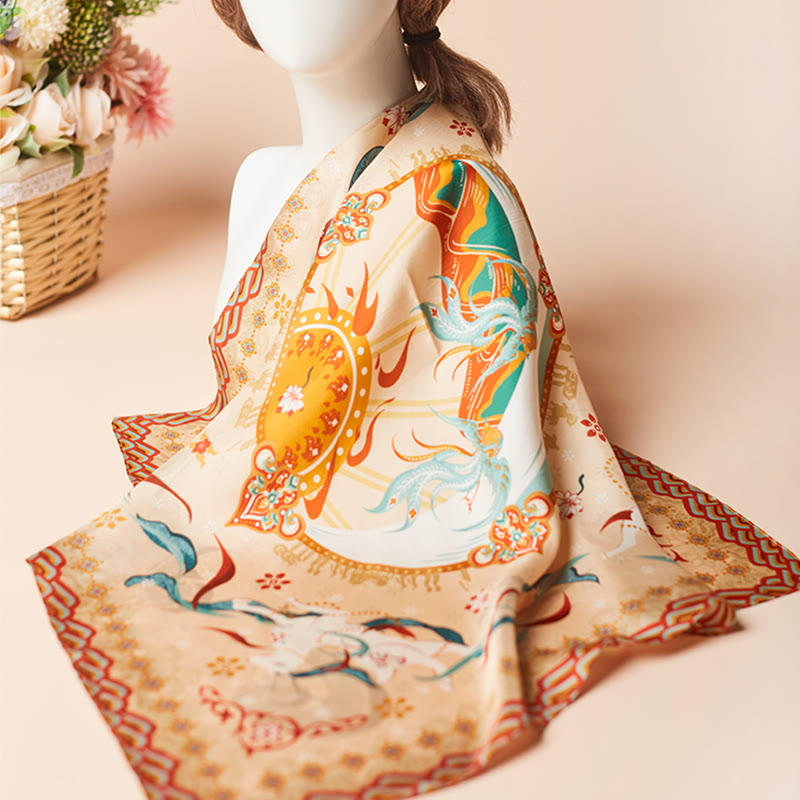
foulards tibétains
2 produits
Affiche 1 - 2 de 2 produits




Bienvenue dans un univers où le tissu est tissé avec intention et histoire. Notre collection de foulards tibétains est bien plus qu'un simple ornement ; ils sont porteurs d'un profond héritage spirituel et d'une signification culturelle, conçus pour vous accompagner dans votre voyage de pleine conscience et de connexion.
Chaque pièce de cette sélection soignée est choisie pour soutenir vos pratiques spirituelles, vous apporter réconfort et vous connecter aux traditions ancestrales. Découvrez la beauté et l'énergie uniques qu'un véritable foulard tibétain peut apporter à votre vie.
L'essence spirituelle profonde des foulards tibétains
Les foulards tibétains, souvent appelés « Khatas » ou « Khadas », sont profondément symboliques dans le bouddhisme et la culture tibétains. Ils représentent la pureté, la bienveillance, la chance et la compassion. Ces foulards sont traditionnellement offerts en guise de cadeau de respect, de bienvenue ou de félicitations lors d'événements importants de la vie, de cérémonies religieuses ou de rencontres avec des personnes estimées.
Offrir un foulard tibétain est un geste chargé d'intentions positives. Il symbolise la pureté du cœur du donateur et est censé apporter chance et prospérité à celui qui le donne comme à celui qui le reçoit. La légèreté du foulard symbolise la pureté de l'intention, et sa longueur peut parfois représenter la grande compassion des Bouddhas et des Bodhisattvas.
Au-delà de l'offrande cérémonielle, ces foulards spirituels sont des rappels quotidiens de pleine conscience et d'interdépendance. Porter ou exposer un foulard tibétain peut favoriser un sentiment de paix et une connexion aux énergies bienveillantes qu'il représente. Ce ne sont pas de simples accessoires, mais des outils d'expression spirituelle et un lien avec une lignée de sagesse.
Chez Healing Sounds, nous honorons cette profonde essence spirituelle. Notre collection de foulards tibétains est sélectionnée avec une compréhension profonde de leur rôle sacré, garantissant que chaque pièce résonne d'authenticité et de respect de ses racines culturelles. Notre objectif est de vous offrir des foulards non seulement magnifiques, mais aussi imprégnés de la profonde énergie spirituelle de l'Himalaya.
Exploration de la qualité des matériaux des écharpes en laine tibétaines et de leurs origines artisanales
La valeur intrinsèque d'un foulard tibétain est intimement liée à sa composition et au savoir-faire des artisans qui le façonnent. Nous sommes convaincus que la qualité des matériaux et l'authenticité du savoir-faire artisanal sont primordiales, notamment pour les articles destinés à un usage spirituel.
L'importance des matériaux authentiques dans chaque écharpe tibétaine
Traditionnellement, les foulards tibétains sont confectionnés à partir de matières variées, la soie et le coton étant les plus courants. Cependant, l' écharpe tibétaine en laine occupe une place particulière, notamment pour sa chaleur, sa durabilité et son lien avec les ressources naturelles de la région himalayenne.
La laine utilisée provient souvent de moutons ou de yaks adaptés à l'environnement himalayen de haute altitude. Appréciée pour sa douceur et ses propriétés isolantes, cette laine rend ces écharpes pratiques pour les climats plus frais ou lors des séances de méditation, où le maintien de la chaleur corporelle est bénéfique.
Nous privilégions la qualité des matières dans notre sélection. Cela signifie privilégier des foulards en fibres naturelles, agréables au toucher et imprégnées de l'énergie de leurs origines. Qu'il s'agisse d'une soie luxueuse au drapé élégant ou d'une laine moelleuse et confortable, la matière elle-même contribue à la vibration spirituelle et à l'expérience utilisateur.
Un matériau de haute qualité garantit la longévité de votre foulard, qui vous accompagnera pendant de nombreuses années et renforcera sa signification personnelle au fil du temps. Il témoigne également d'un respect pour la tradition, où les objets d'importance spirituelle étaient confectionnés pour durer.
Célébration des foulards tibétains faits à la main et de leur patrimoine artisanal
De nombreux foulards tibétains authentiques sont le fruit d'un travail artisanal méticuleux. Ce caractère artisanal, ou authenticité, est crucial, car il relie le foulard à une lignée d'artisans qui ont préservé les techniques traditionnelles de tissage et de teinture depuis des générations.
Les foulards tissés à la main arborent souvent des motifs et des symboles complexes, chacun porteur d'une signification particulière au sein du bouddhisme tibétain. Les légères imperfections des articles faits main ne sont pas des défauts, mais plutôt la marque de leur originalité, conférant à leur charme et à leur authenticité.
La création d'une écharpe tibétaine en laine faite main, par exemple, comporte plusieurs étapes : tonte de la laine, filage, teinture avec des couleurs naturelles ou symboliques, et enfin tissage sur un métier à tisser. Ce processus laborieux imprègne chaque écharpe de l'énergie et du dévouement de l'artisan.
Soutenir les foulards faits main, c'est aussi soutenir les communautés d'artisans qui dépendent de ces savoir-faire traditionnels pour leur subsistance. C'est une façon d'honorer leur patrimoine culturel et de garantir la pérennité de ces magnifiques créations. Chez Healing Sounds, nous nous efforçons de collaborer avec des artisans et des fournisseurs qui perpétuent ces traditions avec intégrité.
Foulards tibétains pour la méditation et les rituels sacrés
L'utilisation des foulards tibétains s'inscrit profondément dans les pratiques spirituelles personnelles, notamment la méditation et divers rituels sacrés. Leur nature symbolique et leur présence douce peuvent considérablement enrichir ces expériences, favorisant la concentration, le recueillement et une connexion plus profonde à la voie spirituelle.
Ces foulards spirituels agissent comme des liens tangibles avec le sacré, transformant un espace ordinaire en un lieu de contemplation et de paix. On les utilise souvent pour orner des statues de divinités, recouvrir des coussins de méditation ou simplement être portés pendant la pratique.
Améliorez votre pratique avec un foulard de méditation
Un foulard tibétain peut être un foulard de méditation efficace, créant une barrière énergétique dédiée et sacrée. En le drapant sur vos épaules ou autour de votre siège de méditation, vous apaiserez votre esprit et signalerez à votre subconscient qu'il est temps de pratiquer.
La douceur et la texture de l'écharpe peuvent vous aider à rester concentré et présent. Pour ceux qui pratiquent dans des environnements plus frais, une écharpe en laine tibétaine peut apporter de la chaleur, permettant des séances de méditation plus longues et plus confortables, sans distraction physique.
Les couleurs et les symboles d'un foulard de méditation peuvent également favoriser la visualisation ou servir de points de convergence. Par exemple, un foulard aux couleurs des chakras peut être utilisé lors de méditations d'équilibrage des chakras, tandis qu'un foulard orné de symboles bouddhistes traditionnels peut approfondir la connexion à ces enseignements spécifiques.
Choisir un foulard qui vous correspond peut en faire un allié précieux dans votre cheminement méditatif. Il devient un réconfort familier, un vêtement zen qui favorise votre travail intérieur et votre vie en pleine conscience.
La tradition tibétaine du châle de prière et sa pertinence moderne
Le concept du châle de prière de style tibétain repose profondément sur l'idée d'imprégner un objet d'énergie spirituelle par son intention et son utilisation. Bien que distincts des grands châles destinés à apporter de la chaleur, les foulards tibétains remplissent souvent une fonction spirituelle similaire, à une échelle plus personnelle.
Lors des rituels, ces foulards peuvent être utilisés pour offrir des prières, effectuer des dédicaces ou participer à des cérémonies de purification. Ils peuvent être considérés comme des textiles sacrés , porteurs de l'empreinte énergétique des prières et des intentions auxquelles ils sont associés.
L'importance d'un vêtement de prière comme le foulard tibétain réside dans sa capacité à créer un espace sacré personnel, où que vous soyez. Que vous soyez à la maison, en voyage ou en groupe, votre foulard peut devenir un élément clé de votre pratique spirituelle.
Chez Healing Sounds, nous comprenons l'importance de ces accessoires de guérison énergétique . Notre collection comprend des foulards pouvant servir de châles de prière, sélectionnés pour leur beauté, leur intégrité matérielle et les intentions positives qu'ils véhiculent.
La polyvalence et l'importance culturelle du foulard tibétain
Le foulard tibétain , comme on l'appelle parfois, témoigne de sa polyvalence, au-delà des contextes purement cérémoniels ou méditatifs. Magnifiques expressions de l'identité culturelle, elles peuvent s'intégrer au quotidien de multiples façons, reflétant un mode de vie conscient et valorisant.
Faisant partie intégrante du costume traditionnel tibétain , les foulards sont portés aussi bien par les laïcs que par les moines. Leur style et la manière dont ils sont portés peuvent indiquer un statut social, une origine régionale ou un rôle spécifique au sein de la communauté. Cette visibilité quotidienne souligne leur profonde intégration à la culture tibétaine.
La beauté d'un foulard tibétain réside dans sa polyvalence. Il peut être élégamment drapé sur les épaules, noué avec art autour du cou, ou même utilisé comme élément décoratif dans un lieu sacré ou à la maison. Cette polyvalence en fait de merveilleux cadeaux tibétains , convenant à un large éventail de personnes appréciant l'art culturel et le symbolisme spirituel.
Nombreux sont ceux qui trouvent que l'intégration de ces foulards à leurs tenues apporte une touche de sérénité et de pleine conscience à leur quotidien. Ces foulards bohèmes , empreints d'une signification profonde, allient esthétique contemporaine et sagesse ancestrale. Ils séduisent ainsi ceux qui recherchent des accessoires de vie consciente et en harmonie avec leurs valeurs.
Le terme « écharpe karma » est parfois utilisé, suggérant que porter ou offrir une telle écharpe peut contribuer à des actions et intentions positives. Bien que ce ne soit pas un terme traditionnel, il reflète l'essence même de la perception de ces objets comme porteurs d'énergie positive et de bienveillance.
Comprendre la distinction entre les foulards et les châles tibétains
Bien que les foulards et les châles tibétains proviennent tous deux des riches traditions textiles de la région himalayenne et partagent une signification culturelle, ils servent à des fins distinctes et diffèrent souvent en taille, en matériau et en utilisation spécifique.
Les foulards tibétains , comme les Kata, sont généralement plus légers, souvent plus délicats et principalement symboliques. Ils sont généralement plus étroits et plus courts que les châles. Leur fonction principale est cérémonielle : offrandes, bénédictions et marques de respect ou de bienvenue. Bien qu'ils puissent être portés, leur rôle de vêtement est souvent secondaire par rapport à leur importance rituelle ou symbolique.
Les châles tibétains, quant à eux, sont généralement plus grands, plus épais et conçus principalement pour apporter de la chaleur au quotidien, notamment dans le climat froid de l'Himalaya. Ce sont des vêtements épais, souvent confectionnés en laine (comme un châle en laine tissé à la main dans l'Himalaya) et qui peuvent être très enveloppants. Si les châles peuvent également avoir une valeur culturelle et artistique, leur fonction première est de protéger des éléments.
Les matières peuvent également varier. Si les écharpes peuvent être en soie, en coton ou en laine légère, les châles sont principalement en laine ou en mélanges plus épais pour une meilleure isolation. Le symbolisme complexe souvent présent sur les écharpes de cérémonie peut également se retrouver sur les châles, mais l'accent est mis sur la chaleur et le confort.
Chez Healing Sounds, notre collection « Écharpes tibétaines » se concentre sur des pièces plus adaptées aux usages cérémoniels, spirituels et décoratifs plus légers. Si vous recherchez des vêtements plus amples et plus chauds, notre collection « Châles tibétains », similaire à celle-ci, sera plus adaptée. Comprendre cette distinction vous aidera à choisir la pièce idéale pour votre usage, qu'il s'agisse d'une écharpe de méditation symbolique ou d'un châle douillet.
Notre engagement envers un approvisionnement éthique pour les foulards spirituels
Chez Healing Sounds, la provenance de nos objets spirituels, dont nos foulards tibétains , est primordiale. Nous sommes profondément attachés à un approvisionnement éthique , garantissant que notre collection non seulement vous apporte beauté et spiritualité, mais soutient également les artisans et les communautés qui les créent de manière juste et respectueuse.
Pour nous, l'approvisionnement éthique implique plusieurs choses. Premièrement, il s'agit de nouer des relations avec des fournisseurs qui partagent nos valeurs d'équité et de transparence. Nous cherchons à comprendre les conditions de fabrication de ces foulards, en privilégiant ceux fabriqués à la main par des artisans rémunérés équitablement pour leur savoir-faire et leur travail.
Deuxièmement, cela implique de privilégier les matériaux naturels et durables autant que possible. Pour une écharpe tibétaine en laine , il peut s'agir de laine provenant d'animaux traités avec respect et traitée avec un impact environnemental minimal. Nous sommes convaincus que l'énergie d'un article est influencée par son cycle de vie complet, de la matière première au produit fini.
Cet engagement s'étend à la préservation du patrimoine culturel. En soutenant un artisanat traditionnel authentique, nous contribuons à la transmission de ces savoir-faire ancestraux aux générations futures. Une écharpe en laine éthique , par exemple, ne se limite pas à la matière, mais témoigne aussi du traitement équitable des tisserands et de la durabilité de leur savoir-faire.
Bien que les chaînes d'approvisionnement des produits artisanaux issus de régions reculées puissent être complexes, nous nous engageons à améliorer continuellement nos pratiques d'approvisionnement. Nous sommes convaincus que les objets utilisés pour la pratique spirituelle doivent incarner les principes de bienveillance et d'intégrité dès leur origine. Cet engagement envers des pratiques éthiques fait partie intégrante de la signature de notre marque Healing Sounds, vous offrant ainsi un sentiment de confiance et vous permettant de faire des choix conscients.
Pourquoi choisir les sons de guérison pour votre écharpe tibétaine authentique
Choisir un foulard tibétain Healing Sounds, c'est choisir un article soigneusement sélectionné avec un profond respect pour ses origines culturelles et spirituelles. Nous sommes plus qu'une simple boutique ; nous sommes un sanctuaire pour ceux qui recherchent des outils authentiques pour leur cheminement spirituel, leur pratique de la méditation et leur vie en pleine conscience.
Notre collection de foulards spirituels est soigneusement sélectionnée pour garantir une qualité authentique et un lien avec les traditions qu'ils représentent. Nous comprenons qu'il ne s'agit pas de simples accessoires, mais de pièces porteuses d'une signification personnelle et énergétique profonde. Que vous recherchiez un châle de prière de style tibétain , une écharpe de méditation vibrante ou un châle tibétain riche en culture, notre sélection reflète notre engagement envers l'authenticité.
Nous nous efforçons de fournir des informations détaillées sur chaque foulard, notamment ses matériaux et, si possible, sa symbolique ou son histoire d'origine. Cette transparence vous permet de faire un choix éclairé, en accord avec vos intentions et vos valeurs. Nous comprenons également l'importance de la qualité des matériaux et de l'authenticité du fait main , des critères que nous privilégions dans notre sélection.
Grâce à notre approche bienveillante et experte, nous sommes là pour vous guider si besoin et vous aider à trouver l' écharpe tibétaine idéale, en harmonie avec votre spiritualité et vos préférences esthétiques. Nous croyons au pouvoir inspirant et réconfortant de ces textiles sacrés , et notre objectif est de vous proposer des pièces qui deviendront des compagnons précieux sur votre chemin.
De plus, notre engagement envers un approvisionnement éthique garantit que votre achat contribue positivement aux communautés d'artisans. En choisissant Healing Sounds, vous optez pour une marque qui valorise l'intégrité, l'authenticité et le profond pouvoir thérapeutique du son, de l'esprit et des objets fabriqués de manière éthique.
Questions fréquemment posées sur les foulards tibétains
La fonction spirituelle première d'un foulard tibétain , souvent appelé khata, est de transmettre bienveillance, pureté et respect . Lors des rituels, il est offert aux lamas, aux statues ou aux invités d'honneur, symbole de pureté et de bon augure. Il est également utilisé lors des bénédictions, des cérémonies et pour marquer les événements importants de la vie.
Les foulards tibétains traditionnels sont généralement confectionnés en soie, en coton ou en laine . Les khatas en soie sont souvent utilisés lors de cérémonies importantes en raison de leur élégance. Les foulards en coton offrent un équilibre entre accessibilité et tradition, tandis que les foulards en laine tibétaine offrent chaleur et durabilité, reflétant l'environnement himalayen.
De nombreux foulards tibétains authentiques, notamment ceux aux motifs complexes ou fabriqués à partir de matériaux traditionnels comme la laine filée à la main, sont bel et bien faits à la main . Ce savoir-faire artisanal est très apprécié, car il ancre le foulard dans une lignée de savoir-faire et donne souvent naissance à des pièces uniques de grande qualité. Il existe cependant des versions plus simples, fabriquées à la machine.
Un foulard tibétain peut servir de foulard de méditation , drapé sur les épaules ou autour de votre espace de méditation, pour créer un sentiment de sacralité et de concentration. Sa texture peut apaiser, et pour certains, ses couleurs ou symboles peuvent favoriser la visualisation. Il permet de marquer un moment dédié à la pratique et peut améliorer le confort.
Les foulards tibétains (comme les khatas) sont généralement plus légers, plus étroits et plus courts, principalement utilisés à des fins symboliques et cérémonielles, comme les offrandes. Les châles tibétains sont plus grands, plus épais et conçus principalement pour offrir chaleur et praticité, souvent confectionnés en laine épaisse. Bien que tous deux soient des textiles culturels, leurs fonctions principales et leurs caractéristiques physiques diffèrent sensiblement.
Pour Healing Sounds, l'approvisionnement éthique des foulards tibétains implique de privilégier une rémunération équitable des artisans, de soutenir l'artisanat traditionnel et de privilégier les matériaux naturels et durables. Nous veillons à ce que nos foulards soient fabriqués dans des conditions respectueuses des créateurs et de l'environnement, dans le respect de valeurs de conscience et de compassion.
Vous trouverez des foulards tibétains authentiques chez des revendeurs spécialisés comme Healing Sounds, qui privilégient les objets spirituels et culturels et l'approvisionnement authentique. Recherchez des vendeurs fournissant des informations sur l'origine, les matériaux et le savoir-faire du foulard. Les marchés artisanaux des régions où vivent des communautés tibétaines ou les boutiques en ligne réputées spécialisées dans l'artisanat himalayen sont également de bonnes sources.
Nous vous invitons à explorer notre sélection soignée de foulards tibétains et à trouver la pièce qui résonne en vous et sublime votre cheminement. Pour un aperçu plus complet de nos articles, vous pouvez également consulter notre collection principale de vêtements et accessoires .



